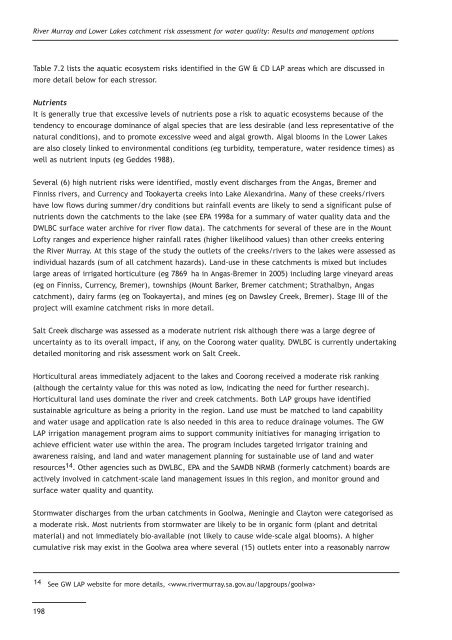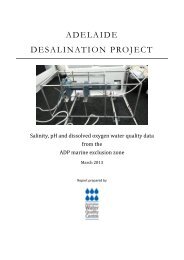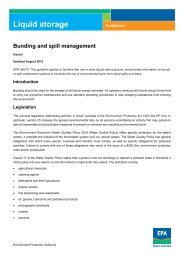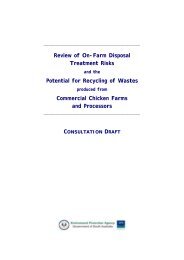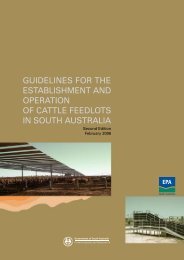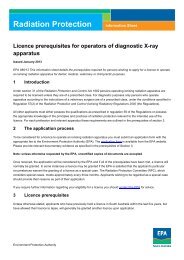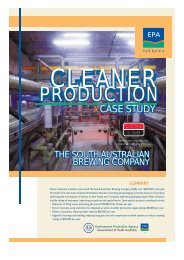2 Renmark to border LAP area assessment - EPA - Sa.gov.au
2 Renmark to border LAP area assessment - EPA - Sa.gov.au
2 Renmark to border LAP area assessment - EPA - Sa.gov.au
Create successful ePaper yourself
Turn your PDF publications into a flip-book with our unique Google optimized e-Paper software.
River Murray and Lower Lakes catchment risk <strong>assessment</strong> for water quality: Results and management options<br />
Table 7.2 lists the aquatic ecosystem risks identified in the GW & CD <strong>LAP</strong> <strong>area</strong>s which are discussed in<br />
more detail below for each stressor.<br />
Nutrients<br />
It is generally true that excessive levels of nutrients pose a risk <strong>to</strong> aquatic ecosystems bec<strong>au</strong>se of the<br />
tendency <strong>to</strong> encourage dominance of algal species that are less desirable (and less representative of the<br />
natural conditions), and <strong>to</strong> promote excessive weed and algal growth. Algal blooms in the Lower Lakes<br />
are also closely linked <strong>to</strong> environmental conditions (eg turbidity, temperature, water residence times) as<br />
well as nutrient inputs (eg Geddes 1988).<br />
Several (6) high nutrient risks were identified, mostly event discharges from the Angas, Bremer and<br />
Finniss rivers, and Currency and Tookayerta creeks in<strong>to</strong> Lake Alexandrina. Many of these creeks/rivers<br />
have low flows during summer/dry conditions but rainfall events are likely <strong>to</strong> send a significant pulse of<br />
nutrients down the catchments <strong>to</strong> the lake (see <strong>EPA</strong> 1998a for a summary of water quality data and the<br />
DWLBC surface water archive for river flow data). The catchments for several of these are in the Mount<br />
Lofty ranges and experience higher rainfall rates (higher likelihood values) than other creeks entering<br />
the River Murray. At this stage of the study the outlets of the creeks/rivers <strong>to</strong> the lakes were assessed as<br />
individual hazards (sum of all catchment hazards). Land-use in these catchments is mixed but includes<br />
large <strong>area</strong>s of irrigated horticulture (eg 7869 ha in Angas-Bremer in 2005) including large vineyard <strong>area</strong>s<br />
(eg on Finniss, Currency, Bremer), <strong>to</strong>wnships (Mount Barker, Bremer catchment; Strathalbyn, Angas<br />
catchment), dairy farms (eg on Tookayerta), and mines (eg on Dawsley Creek, Bremer). Stage III of the<br />
project will examine catchment risks in more detail.<br />
<strong>Sa</strong>lt Creek discharge was assessed as a moderate nutrient risk although there was a large degree of<br />
uncertainty as <strong>to</strong> its overall impact, if any, on the Coorong water quality. DWLBC is currently undertaking<br />
detailed moni<strong>to</strong>ring and risk <strong>assessment</strong> work on <strong>Sa</strong>lt Creek.<br />
Horticultural <strong>area</strong>s immediately adjacent <strong>to</strong> the lakes and Coorong received a moderate risk ranking<br />
(although the certainty value for this was noted as low, indicating the need for further research).<br />
Horticultural land uses dominate the river and creek catchments. Both <strong>LAP</strong> groups have identified<br />
sustainable agriculture as being a priority in the region. Land use must be matched <strong>to</strong> land capability<br />
and water usage and application rate is also needed in this <strong>area</strong> <strong>to</strong> reduce drainage volumes. The GW<br />
<strong>LAP</strong> irrigation management program aims <strong>to</strong> support community initiatives for managing irrigation <strong>to</strong><br />
achieve efficient water use within the <strong>area</strong>. The program includes targeted irriga<strong>to</strong>r training and<br />
awareness raising, and land and water management planning for sustainable use of land and water<br />
resources14 . Other agencies such as DWLBC, <strong>EPA</strong> and the SAMDB NRMB (formerly catchment) boards are<br />
actively involved in catchment-scale land management issues in this region, and moni<strong>to</strong>r ground and<br />
surface water quality and quantity.<br />
S<strong>to</strong>rmwater discharges from the urban catchments in Goolwa, Meningie and Clay<strong>to</strong>n were categorised as<br />
a moderate risk. Most nutrients from s<strong>to</strong>rmwater are likely <strong>to</strong> be in organic form (plant and detrital<br />
material) and not immediately bio-available (not likely <strong>to</strong> c<strong>au</strong>se wide-scale algal blooms). A higher<br />
cumulative risk may exist in the Goolwa <strong>area</strong> where several (15) outlets enter in<strong>to</strong> a reasonably narrow<br />
14 See GW <strong>LAP</strong> website for more details, <br />
198


